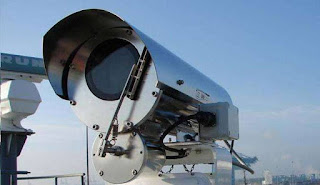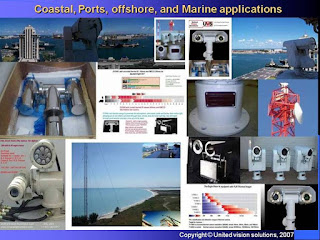www.longrangecamera.com
EV3000-D-IR series using FLIR thermal imager.
United Vision Your source for the best in professional quality CCTV equipment and accessories. We are a supplier of surveillance equipment, specialized cameras (IR camera, IR cooled Thermal imager, Un-cooled Thermal camera, Day/Night Long range, and Gen III Night vision camera), image transmission systems and integrated vehicle systems for military, police, emergency services and intelligence applications. We also specialize in Border surveillance incorporating thermal imager, cameras, radar, and real-time links.
There is however a multitude of choices of thermal imaging camera systems for mid to long-range surveillance in the commercial marketplace. An often asked question is. “Should I use a cooled or an uncooled thermal imaging system and which one is the most cost-effective?”
The security market is an industry that is very price sensitive and competitive. A case has to be made for a purchase of any one particular high-value thermal imaging camera system for long-range surveillance. Certainly when there are other, seemingly equivalent systems out there at a lower cost. This technical note describes the two classes of long-range thermal imaging camera systems available on the market today: the cooled and uncooled systems. The component costs for these two classes of a system can be quite different, making it extremely important to decide which way to go.
Cooled thermal imaging cameras
A modern cooled thermal imaging camera has an imaging sensor that is integrated with a cryocooler. This is a device that lowers the sensor temperature to cryogenic temperatures. This reduction in sensor temperature is necessary to reduce thermally-induced noise to a level below that of the signal from the scene being imaged.
Cryocoolers have moving parts made to extremely close mechanical tolerances that wear out over time, as well as helium gas that slowly works its way past gas seals. Eventually, a rebuild for the cryocooler is required after 8,000-10,000 hours of operation. Cooled thermal imaging cameras are the most sensitive type of cameras to small differences in scene temperature. They can detect the smallest of temperature differences between objects. They can be produced to an image in the midwave infrared or MWIR band of the spectrum where the thermal contrast is high due to blackbody physics. Thermal contrast is the change in signal for a change in target temperature. The higher the thermal contrast, the easier it is to detect targets against a background that may not be much colder or hotter than the target. Generally speaking, the images from MWIR cameras pointed at nighttime scenes of interest show quite vivid contrast compared to other infrared wavebands.
Uncooled thermal imaging cameras
An uncooled infrared camera is one in which the imaging sensor does not require cryogenic cooling. A common detector design is based on the microbolometer, a tiny vanadium oxide resistor with a large temperature coefficient on a silicon element with a large surface area, low heat capacity, and good thermal isolation. Changes in scene temperature cause changes in the bolometer temperature which are converted to electrical signals and processed into an image. Uncooled sensors are designed to work in the Longwave infrared or LWIR band from 7 to 14 microns in wavelength, where terrestrial temperature targets emit most of their infrared energy.
Uncooled cameras are generally much less expensive than their counterparts, the cooled infrared cameras. The sensors can be manufactured in fewer steps with higher yields relative to cooled sensors, less expensive vacuum packaging, and uncooled cameras do not require cryocoolers, which are very costly devices.
Uncooled cameras have fewer moving parts and tend to have much longer service lives than cooled cameras under similar operating conditions. Security applications often require continuous operation of cameras to avoid the possibility of missing any threats.
Cooled cameras will generally require servicing after 1-2 year of operation, while an uncooled camera might work continuously for years.
Cooled of uncooled? What to choose? All these advantages of uncooled cameras beg the question: Under what circumstances is it appropriate to use cooled cameras? The answer is that when standoff ranges get out to 5km or greater, thermal imaging systems based on cooled cameras can quickly become more cost-effective. Note the emphasis on the word "systems" – the camera is only one component of an imaging "system". One of the biggest cost drivers of a long-range uncooled camera system is the lens. As effective range requirements increase, the lenses for uncooled camera systems become so bulky and expensive that it can often be cheaper to specify a cooled camera with an equivalent focal length lens instead.
Conclusion: Long range thermal infrared surveillance applications require long focal length lenses, and the cost of lenses increases rapidly with focal length for uncooled camera systems and rather slowly for cooling systems. As a result, even though the cost of a cooled camera core is much higher than an uncooled core, the system cost (core plus lens) for uncooled surpasses cooled system cost at a focal length
on the order of 350mm. Useful imaging of man-sized targets at multi-km ranges requires focal lengths that exceed 350mm. Therefore, multi-km imaging of man-sized targets is less expensive with a cooled camera system, at least for the initial system cost. It is important that the system designer factors in the 8,000-10,000 hour lifetime of cryocoolers into the cost model arrive at the best solution. If the cryocooler needs a servicing every 2 years, and the cost is 10% of the total system, then the 4-year cost of the cooling system is really 1.2X the initial system cost.
Acknowledgment to Dr. Austin Richards Ph. D. for authoring the article and to Pierre Boulanger for his contribution.















































